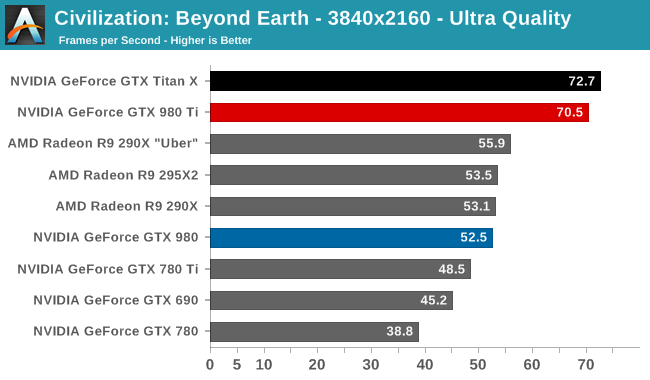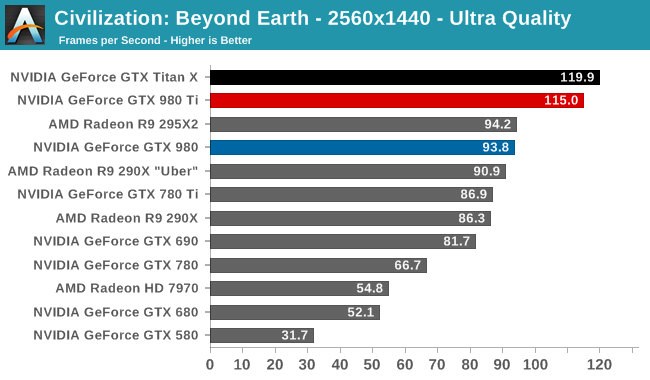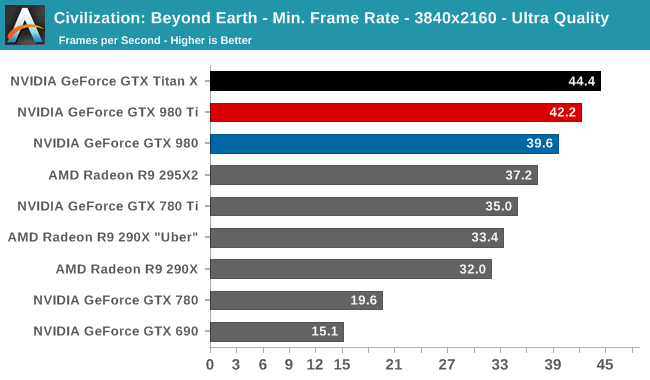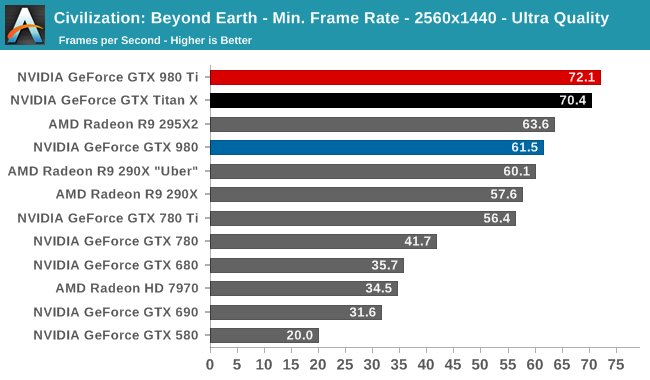The NVIDIA GeForce GTX 980 Ti Review
by Ryan Smith on May 31, 2015 6:00 PM ESTCivilization: Beyond Earth
Shifting gears from action to strategy, we have Civilization: Beyond Earth, the latest in the Civilization series of strategy games. Civilization is not quite as GPU-demanding as some of our action games, but at Ultra quality it can still pose a challenge for even high-end video cards. Meanwhile as the first Mantle-enabled strategy title Civilization gives us an interesting look into low-level API performance on larger scale games, along with a look at developer Firaxis’s interesting use of split frame rendering with Mantle to reduce latency rather than improving framerates.


Stop me if you’ve heard this one before: the GTX 980 Ti and GTX Titan perform within a few percent of each other. Under Civilization the gap between the two is a hair larger than in other games, at 3-4%, but this is also as large of a gap as you’ll see for average framerates. Even here the two are for all meaningful purposes tied.
Meanwhile on an absolute basis, the GM200 twin remain the only single-GPU cards to crack 60fps, with GTX 980 Ti delivering 70.5fps at the game’s most extreme setting. This is once again well ahead of the GTX 980 – beating it by 34% at 4K, though by less at lower resolutions where we start to get CPU-bottlenecked.
I also want to quickly touch upon how the GTX 980 Ti compares to the last-generation high-end GK110 Kepler cards, the GTX 780 and GTX 780 Ti. Against GTX 780 in particular, in this test we see the GTX 980 Ti deliver 70-80% better performance. With this being the 2 year anniversary of the GTX 780’s release, this is especially notable since it’s such a good example of how performance has improved specifically at this $649 price point in the last 2 years. GM200 in general is not this fast versus GK110 – there’s only so much to be done at 28nm – but against GTX 780 in particular NVIDIA’s latest card looks quite good. Even GTX 780 Ti is not entirely immune, with GTX 980 Ti beating it by around 45% at 4K.


When it comes to minimum framerates the same story continues; the two GM200 cards are very close to each other, staying within 5%. At worst, you can say that the 7-17% performance advantage over the GTX 980 isn’t very impressive, though this is admittedly a game that’s not too far off from being CPU-bottlenecked.










290 Comments
View All Comments
chizow - Monday, June 1, 2015 - link
Yes, its unprecedented to launch a full stack of rebrands with just 1 new ASIC, as AMD has done not once, not 2x, not even 3x, but 4 times with GCN (7000 to Boost/GE, 8000 OEM, R9 200, and now R9 300) Generally it is only the low-end, or a gap product to fill a niche. The G92/b isn't even close to this as it was rebranded numerous times over a short 9 month span (Nov 2007 to July 2008), while we are bracing ourselves for AMD rebrands going back to 2011 and Pitcairn.Gigaplex - Monday, June 1, 2015 - link
If it's the 4th time as you claim, then by definition, it's most definitely not unprecedented.chizow - Monday, June 1, 2015 - link
The first 3 rebrands were still technically within that same product cycle/generation. This rebrand certainly isn't, so rebranding an entire stack with last-gen parts is certainly unprecedented. At least, relative to Nvidia's full next-gen product stack. Hard to say though given AMD just calls everything GCN 1.x, like inbred siblings they have some similarities, but certainly aren't the same "family" of chips.Refuge - Monday, June 1, 2015 - link
Thanks Gigaplex, you beat me to it... lolchizow - Monday, June 1, 2015 - link
Cool maybe you can beat each other and show us the precedent where a GPU maker went to market with a full stack of rebrands against the competition's next generation line-up. :)FlushedBubblyJock - Wednesday, June 10, 2015 - link
Nothing like total fanboy denialKevin G - Monday, June 1, 2015 - link
The G92 got its last prebrand in 2009 and was formally replaced on in 2010 by the GTX 460. It had a full three year life span on the market.The GTS/GTX 200 series as mostly rebranded. There was the GT200 chip on the high end that was used for the GTX 260 and up. The low end silently got the GT216 for the Geforce 210 a year after the GTX 260/280 launch. At this time, AMD was busy launching the Radeon 4000 series which brought a range of new chips to market as a new generation.
Pitcairn came out in 2012, not 2011. This would mimic the life span of the G92 as well as the number of rebrands. (It never had a vanilla edition, it started with the Ghz edition as the 7870.)
chizow - Monday, June 1, 2015 - link
@Kevin G, nice try at revisionist history, but that's not quite how it went down. G92 was rebranded numerous times over the course of a year or so, but it did actually get a refresh from 65nm to 55nm. Indeed, G92 was even more advanced than the newer GT200 in some ways, with more advanced hardware encoding/decoding that was on-die, rather than on a complementary ASIC like G80/GT200.Also, at the time, prices were much more compacted at the time due to economic recession, so the high-end was really just a glorified performance mid-range due to the price wars started by the 4870 and the economics of the time.
Nvidia found it was easier to simply manipulate the cores on their big chip than to come out with a number of different ASICs, which is how we ended up with GTX 260 core 192, core 216 and the GTX 275:
Low End: GT205, 210, GT 220, GT 230
Mid-range: GT 240, GTS 250
High-end: GTX 260, GTX 275
Enthusiast: GTX 280, GTX 285, GTX 295
The only rebranded chip in that entire stack is the G92, so again, certainly not the precedent for AMD's entire stack of Rebrandeon chips.
Kevin G - Wednesday, June 3, 2015 - link
@chizowOut of that list of GTS/GTX200 series, the new chip in that line up in 2008 was the GT200 and the GT218 that was introduced over a year later in late 2009. For 9 months on the market the three chips used in the 200 series were rebrands of the G94, rebrands of the G92 and the new GT200. The ultra low end at this time was filled in by cards still carrying the 9000 series branding.
The G92 did have a very long life as it was introduced as the 8800GTS with 512 MB in late 2007. In 2008 it was rebranded the 9800GTX roughly six months after it was first introduced. A year later in 2009 the G92 got a die shrink and rebranded as both the GTS 150 for OEMs and GTS 250 for consumers.
So yeah, AMD's R9 300 series launch really does mimic what nVidia did with the GTS/GTX 200 series.
FlushedBubblyJock - Wednesday, June 10, 2015 - link
G80 was not G92 not G92b nor G94 mr kevin g